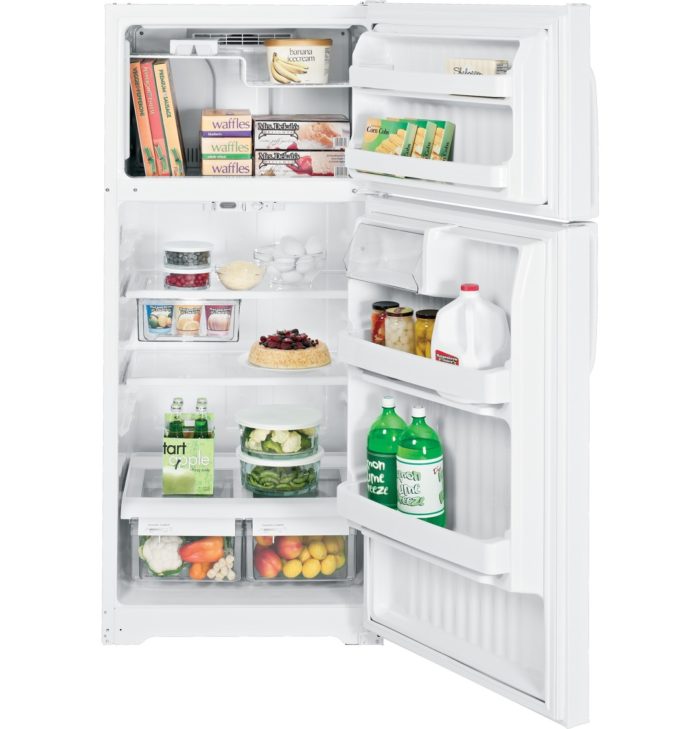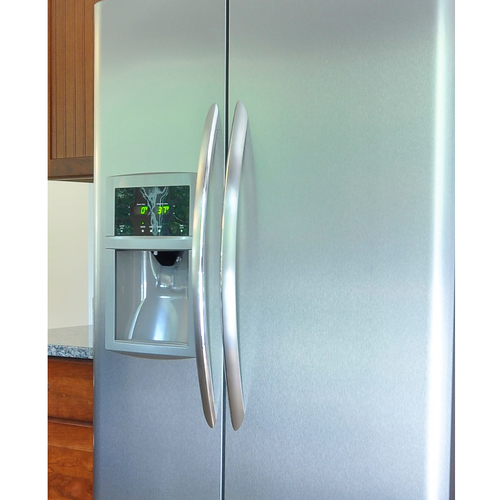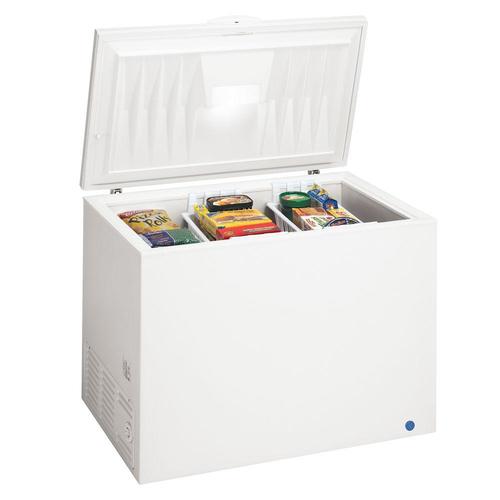
Image Credit: GE
When we moved into our house, it had the original Maytag 18.5-cubic-foot refrigerator that was installed in 2000. It had one feature I had never lived with before: an icemaker.
It took me some time to realize that the weird sounds I occasionally heard coming from the fridge was it cranking out the cubes. We don’t use much ice, and being middle-aged actually learned in our youth how to fill ice cube trays (similar to being able to count, and tell time by the big hand and the little hand, and other lost arts), so eventually I turned that feature off.
Researchers at NIST recently reported that they tested four new refrigerators and the icemakers added 12 to 20 percent to the rated energy consumption. The not-so-cool discovery was that 75% of this energy comes from heating the molds to release the ice. Duh.
Oh, and the ratings you see on the big yellow sticker don’t include the energy used by the icemaker, apparently because someone decided it would be too hard to measure. Double duh.
The old refrigerator uses too much electricity
Anyway, being a complusive measurer, I plugged the Maytag into a kWh meter and measured its usage during March. This is a time of year where the house is perhaps slightly cooler than average. The annualized energy usage was 655 kWh. I knew I could do better, and maybe find a quieter refrigerator also.
I checked the Energy Star ratings and learned that the most efficient refrigerators were 16.5-cubic-foot models made by GE*, and that they didn’t make them anymore. This despite the fact that these units were well reviewed by owners.
Moving up to an 18.1-cubic-foot unit added 11 kWh/year, so after a few days of trying to find the last 16.5-cubic-foot model left, I capitulated to being an American and found that the 18.1-cubic-foot one I wanted was also discontinued in favor of a newer version that used more energy. Duh. (Are you sensing a trend here?)
I found the one I wanted, on sale as it happened, being discontinued and all, and bought it. It cost $517 shipped to Martha’s Vineyard (land of “No Free Shipping” Zip codes). It does not have an icemaker. It is rated at 335 kWh/year.
Comparing the cost of an efficient refrigerator to the cost of PV
I’ve been measuring its energy consumption and after about six weeks it looks like we’re headed for an annual energy usage of 260 kWh, unless it goes way up in the summer.
I gave the Maytag away. (I learned to my chagrin that all three of my work colleagues who immediately responded to my offer were intending to use this as a second, in-the-basement fridge.) The GE seems quieter than the Maytag, which we appreciate.
One test I use to evaluate whether something is a reasonable energy investment is to look at kWh saved and compare that with the cost of solar electric capacity to generate the equivalent amount of energy. In my opinion, this is reasonable, as long as the investments being compared have similar service life. I thought that a fridge mightn’t last as long as a solar electric system, so this wasn’t an optimal comparison. Anyway, here on Martha’s Vineyard we see that one watt of PV will make about 1.3 kWh/year, and has a marginal cost before subsidies of perhaps $4 – $5. If the GE fridge saves 400 kWh/year, that’s the output of about 300 W of PV costing $1,350 (assuming a cost of $4.50/watt for PV). So the fridge looks good.
* The most efficient refrigerators are actually still Sunfrost, but the margin is getting smaller, and the PVs cost less per kWh saved, and plus they are a pain to actually use because they are cube shaped so you need orangutan arms to reach half the stuff.
Marc Rosenbaum is director of engineering at South Mountain Company on the island of Martha’s Vineyard in Massachusetts. He writes a blog called Thriving on Low Carbon.
Weekly Newsletter
Get building science and energy efficiency advice, plus special offers, in your inbox.















7 Comments
Which one is more efficient?
I've been investigating refrigerators as well, and I created a spreadsheet to see the comparisons in black and white.
A Sunfrost RF19 freezer on bottom (their largest)—rated at 372 kWh, does indeed seem most efficient.
I compared it with a Maytag MBR2258XES freezer on bottom 21.9 cu.ft. (their smallest)—rated at 403 kWh.
Doing the math, the Maytag becomes more efficient on a per cubic foot basis: 19.58 kWh for the Sunfrost and 18.4 kWh for the Maytag. And the Maytag is about 1/3 the cost.
Which GE model did you find was more efficient than the Maytag?
David McNeely
David,
Appliance models change all the time, which is frustrating for shoppers. Current models probably differ from the time when Marc did his research.
Check out the Energy Star web site (Marc provides a link at the top of his 6th paragraph). I noticed that GE is now offering six 16.5-cu. ft. models that are rated at 300 kwh/year. (Click the image below to enlarge it.)
.
Finding the fridge
Sometimes the models listed on the EStar site are not possible to actually buy (sorta like Consumer Reports, you can never actually buy the top-rated model :-). So you find the model you want and Google around. Note that many model numbers are very similar and yet have different energy usage, so use all the digits! And don't sweat 10 kWh/year...
Refrigerator Energy Use
While not directly related to energy use, here is something to consider when replacing your refrigerator. They are available with either an old fashioned mechanical thermostat and a really cool digital electronic one to control the compressor. The latter is very appealing, but when the electronics board that drives it fails it will cost you $300 to replace. Ours failed after 3 years (GE Profile). I would not have noticed if I had not rechecked the energy use with a kWh meter. It was way high. Looking closer I found the condenser fan was not running. It's a DC fan so not easy to test it. So we had to have a service call and they found it was the board not the fan. Not covered by warranty. It might have been if the compressor had failed within the 5 year warranty on it, but not otherwise. The only practical way to detect this failure is with a kW meter. I would opt for the simple mechanical thermostat control and buy a thermometer for $20 bucks to read the temperature in the box.
smaller refrigerators
Another problem with efficient refrigeration is finding refrigerators that are sized correctly for smaller households. While living in Chile last year it was easy to find a smaller refrigerator that used <16kWh options.
Speaking of smaller refrigerators
Just yesterday I was in a BJs warehouse. They had for sale a Haier mini-fridge, 3.3 Cu Ft per the yellow energy guide label
The little beast is rated to burn 338 kWh per year even though it is manually defrosted!
Those ought not to be legal to sell.
Reponse to Curt Kinder
Curt,
You're right -- buyers have to be alert. My Sunfrost refrigerator is 3 times bigger than that little Haier -- and the Sunfrost uses only half as many kWh per year.
Log in or create an account to post a comment.
Sign up Log in